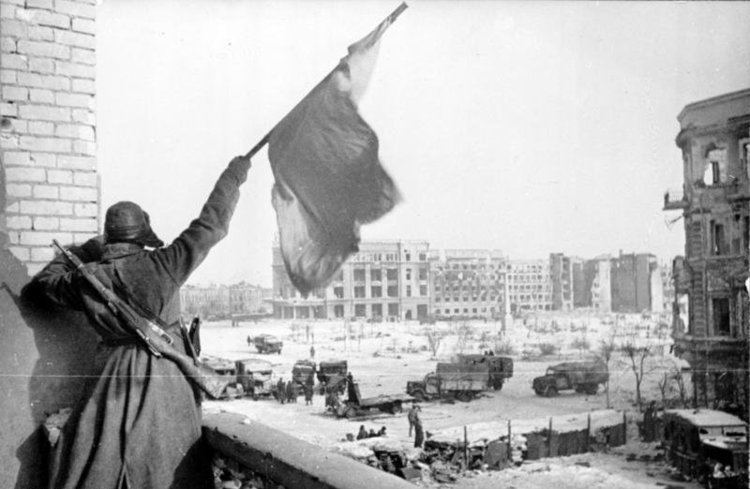Result Soviet victory | Location Volgograd, Russia | |
 | ||
212,000 troops6,860 guns and mortars257 tanks300 aircraft 250,000 soldiers4,130 guns and mortars300 tanks100 aircraft Similar World War II, Operation Little Saturn, Operation Uranus, Operation Winter Storm, Zhitomir–Berdichev Offensive | ||
Operation Koltso (Operation Ring) was the last part of the Battle of Stalingrad. It resulted in the capitulation of the remaining Axis forces encircled in the city.
Contents
The attack
The operation was launched on 10 January 1943 with a mass artillery bombardment of the German positions outside the city by the seven encircling Soviet armies. In the first three days, the Soviets lost 26,000 men and over half their tanks. The western half of the Stalingrad pocket had been lost by 17 January.
On the 10th, it became clear the main goal was the Pitomnik airfield. "The 44th, 76th and 28th (Motorised) Infantry Divisions were badly hit." The 3rd (Motorised) Infantry Division, deployed on the southwestern corner of the cauldron since the end of Nov. 1942, was ordered to retreat to new defensive positions to avoid encirclement.
The fighting then paused for four days while the Soviet forces regrouped and redeployed for the next phase of the operation. The second phase of the offensive began on 20 January with a Soviet push toward the airfield at Gumrak. Two days later, the airfield was occupied by the Soviets. Its capture meant an end to the evacuation of the German wounded and that any further air supply would have to be by parachute.
Paulus on 22 January sent a radio message to OKH:
Russians in action in 6 km wide on both sides Voroponovo, some with flags unfurled to the east. No way to close the gap. Withdrawal to neighboring fronts who are also without ammunition, useless and not feasible. Supply with ammunition from other fronts also no longer possible. Food at an end. More than 12,000 unprovided for wounded in the encirclement. What orders shall I give the troops who have no more ammunition and will be further attacked with heavy artillery, tanks and massed infantry? Fastest decision necessary because dissolution in some places already started. Confidence in the leadership still exists.
The Axis retreated back into the city itself. But resistance to the Soviet advance gradually diminished due to the exhaustion of all supplies on the Axis side. On 25 January, LI Corps commander Walther von Seydlitz-Kurzbach told his divisional commanders to decide for themselves on the matter of surrender. He was immediately relieved of his command by Paulus. Seydlitz-Kurzbach later fled the German lines under German fire and personally surrendered to the Soviets.
On 26 January, detachments of 21st Army met up with the 13th Guards Division to the north of the Mamaev Kurgan, which cut the Axis pocket in Stalingrad in two. Paulus and many of his senior German commanders were in the smaller southern pocket based in the city center of Stalingrad. The northern pocket was led by XI Corps commander General Strecker and centered in the area around the tractor factory.
In bitter fighting, the Soviets gradually cleared the city center. By 31 January, German resistance in the southern pocket was confined to individual buildings. Soviet forces reached Paulus's headquarters in the Univermag Department Store and the remaining German soldiers ceased their resistance. Soviet Staff officers entered the building and negotiated terms with General Schmidt. Paulus refused to participate directly. In Soviet captivity, Paulus denied having surrendered, claiming to have been taken by surprise. He refused to issue an order to the remaining Germans in the southern pocket to surrender. He also denied having the authority to issue an order for the northern pocket to surrender.
The entire Soviet force at Stalingrad now concentrated on the northern pocket. Intense artillery fire was used to reduce resistance. Soviet forces then followed up, destroying any remaining bunkers, often with direct fire at short range from tanks or artillery. General Strecker continued to resist based on the idea that tying down the Soviet armies at Stalingrad as long as possible would help the German situation elsewhere in the Soviet Union.
The battle ends
By the early morning of 2 February, Strecker was informed that one of his officers had gone to negotiate surrender terms with the Soviets. He then decided to put an end to the fighting. He sent a radio message to Germany, saying that his command had performed its duty to the last man and then surrendered. Organized Axis resistance in the city ended.
